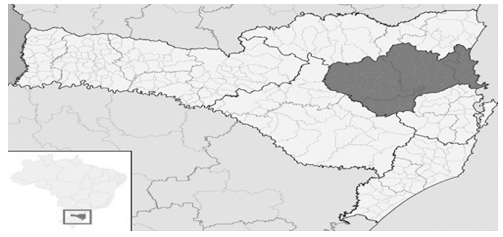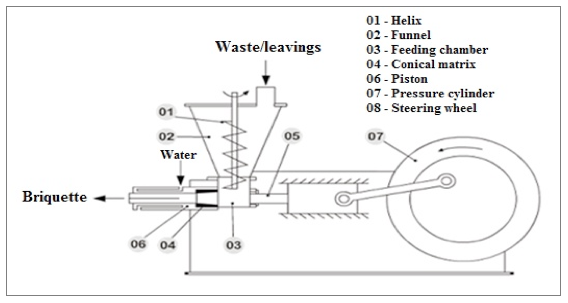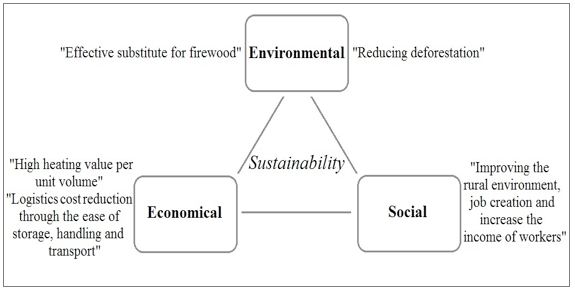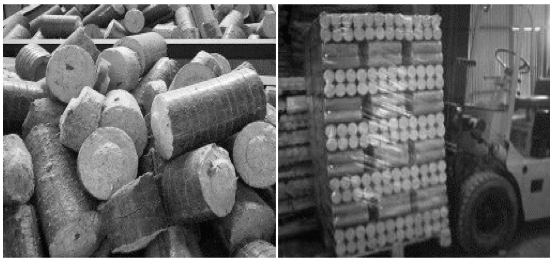

 HOME | ÍNDICE POR TÍTULO | NORMAS PUBLICACIÓN
HOME | ÍNDICE POR TÍTULO | NORMAS PUBLICACIÓN Espacios. Vol. 37 (Nº 13) Año 2016. Pág. 18
Tiago Henrique de Paula ALVARENGA 1; Simone SARTORI; Lucila Maria de Souza CAMPOS; Carlos Manuel Taboada RODRIGUEZ
Recibido: 27/01/16 • Aprobado: 02/03/2016
ABSTRACT: The objective of this article was to establish a case study regarding the sustainable energy production. It was shown that the production of briquettes is effective regarding the sustainable energy production, and also creates jobs for rural communities, reduce deforestation and meet the market demands. However, for the development of national briquettes industry, researches need to be stimulated and technological innovations created, with respect to cost reduction, especially in relation to logistic costs of transportation of raw material which was identified as the object more burdens the cost of production. |
RESUMO: O objetivo deste artigo foi realizar um estudo de caso no que tange a produção sustentável de energia. Identificou-se que a produção é efetiva em relação produção sustentável de energia, sendo que gera empregos para comunidades rurais, reduz o desmatamento e atende as demandas mercadológicas. Entretanto, para o desenvolvimento da indústria de briquetes nacional, são necessários que pesquisas sejam estimuladas e inovações tecnológicas criadas, no que tange a redução dos custos, principalmente em relação aos custos logísticos de transporte de matéria-prima que foi identificado como o objeto que mais onera o custo de produção. |
Since the beginning of the industrial revolution, the technological breakthroughs have been multiplied and the general feeling of well-being has substantially improved. However, this spectacular success, perhaps unnecessarily, resulted in many environmental problems (Wu, 2013). Within the current issues during the last two decades - such as global warming due to the burning of fossil fuels and energy security - there is an intensification by energy alternatives from renewable sources (Hu et al., 2014; Corscadden et al., 2014).
The social awareness about environmental problems exponentially grew in the late twentieth century. Among these problems, issues like deforestation, sustainable management and forest preserving have been given great prominence, encouraging environmental campaigns and refusal to products from tropical forests, or even the substitution of wood for alternative products (Nardelli, Griffith, 2003).
The use of biomass as an energy source is one of the alternatives to mitigate the harmful effects of global warming. Biomass can be obtained from two main sources. These sources are energy crops and lignocellulosic waste from agroforestry. This second alternative offers advantage in properly allocate potential environment polluters (Protasio et al., 2012).
Annually large volumes of biomass wastes are generated as byproducts from agricultural sectors, for example, rice husks, coffee, wood chips and sawdust (Sugumaran, Seshadri, 2010). In Brazil, 14 million tons of wood waste are produced per year, including sawdust, slabs, feet and tip of logs, sawdust and logs are discarded by faults and defects, derived from planted eucalyptus and pinus woods, come from their 5.6 million hectares, such from native forests (Almeida et al., 2011).
Most of the time, these residues are burned without the use of its heat or left to rot on the environment; subsequently, are emitters of greenhouse gases and causing other environmental problems (Mwampamba et al., 2013). The waste, when economically harnessed, have an environmental advantage over fossil fuels because it is carbon neutral (Almeida et al., 2011; Pimenta et al., 2015).
In this therms, biomass, domestic and abundant energy source, presents itself as an opportunity for renewable energy front the use of fossil fuels, converting low density in high energy density (Sugumaran, Seshadri, 2010). Biomass can be directly used to generate heat or electricity or processed into solid biofuels such as briquettes, pellets, ethanol, biodiesel and biogas (Dias et al., 2012).
In Europe there is a briquettes demand of about five million tonnes a year, that amounts to an estimated $700 million value. This demand is more directed to the generation of industrial energy and home heating (Vinterback, 2006). In Brazil it is mentioned that the wood briquette is an emerging product in the unorganized market with concentrated demands in a few regions (Almeida et al., 2011).
However, the wood waste is not well underutilized in a sustainable manner, not only in Brazil but in the world. When this material is turned into energy or other value-added product, it is removed from the environment, creating new industries, generating wealth and jobs for nearby populations the processing unit (Almeida et al., 2011). These attributes make a company become sustainable and balanced in three pillars: environmental, economic and social (Elkington, 1994; Lozano, 2012; Wu, 2013).
The objective of this research was to conduct a case study regarding the sustainable energy production. Therefore, the briquettes production of an industry located in Itajaí Valley in the state of Santa Catarina was analyzed. The study focus was the sustainable energy production in economic, social and environmental dimensions, through a 9 prospects analysis.
This study has a qualitative approach, which according Neves (1996) comprises a set of interpretative techniques and aims to describe and decode the components of a complex meanings system. On the technical procedures, it is a case for being a further study on the briquettes production with respect to sustainability in a specific industry.
This is an empirical case study that investigates a certain phenomenon, usually present (energy production from waste) within a real context (the researched industry), when the boundaries between the phenomenon and the context in which he inserts are not clearly defined. This is an in-depth analysis of one or more cases, allowing the broad and detailed knowledge (Gil, 1996).
According to Yin (2001), the case study is the most appropriate strategy for research which tries to solve problem issues such as the following examples: (i) how the technology is being used, (ii) which are the existing technologies and (iii) why this type of technology is used.
In order to implement this research, initially was carried out a review of the national and international literature to construct the knowledge about renewable energy, aiming to analyze the briquettes production. This initial step, we sought to make a connection between the briquettes production and the environmental, economic and social sustainability.
In the second research stage, basic information on existing briquetting initiatives in Brazil by consulting the reports and information available in public documents were obtained (reliable sources such as the National Energy Balance, Brazilian Enterprise for Agricultural Research in and the Brazilian Biomass and Renewable Energy Industries Association).
As a last research step, a case study was conducted in a briquette industry located in the Itajaí Valley rural area, in the state of Santa Catarina (Figure 1).
Figure 1. Itajaí Valley Region, in the state of Santa Catarina

The state of Santa Catarina holds 11% of the pinus and eucalyptus area in the country. It is the fourth largest forest products exporter. The state furniture sector is the largest and leading Brazilian furniture exporter, followed by Rio Grande do Sul and São Paulo (Sebrae-SC, 2010).
The state of Santa Catarina representation in this industry makes the generation of waste sharper and consequently increases the waste availability, because according to Furtado (2010), the forestry industry, as a whole, is characterized by the great waste generation to throughout the production process.
The company under study started to operate in September 2005. With an initial production of 80 tons per month, the company expanded its production because of the demand that quickly emerged and currently produces about 500 tons of briquettes per month.
The case study was conducted using a semi-structured interview with the industry owner and staff. To enrich the data, on-site visits of the plant and a consultation to documents submitted by management were carried out. The interview protocol was based on research of Felfi et al. (2011), Stolarski et al. (2013), Corscadden et al. (2014) and Hu et al. (2014). The interview/survey conduction involved economic, environmental and social analysis, and addressed the following perspectives: (1) technology type used in the briquetting; (2) residues from the process; (3) sustainable performance of the company; (4) type of raw material, energy power and product design; (5) energy type used in production; (6) production and transportation cost; (7) government incentives; (8) number of employees and (9) the existence of certifications.
In this section, the 9 prospects considered in the interview which present the results of this case study will be treated. Thus, every prospect is uniquely treated in the following paragraphs.
The briquette is made through the technological process (prospect-1) of a mechanical compression in a briquetting machine and does not use any binder or chemical component in the process. It is, therefore, a condensate made of wood waste discarded by the industry, mixed with sawdust (Figure 2). As the interviewee manager, the company acquires the residue (sawdust pinus and eucalyptus) for processing into briquettes within a 90 km radius.
Figure 2. The architecture of a briquettes processor

Fonte: Biomaxind (2014)
According to the manager, since during the briquette manufacture occurs the sawdust pressing and there is no residues from this process (prospect – 2), 1 ton of sawdust is equivalent to 1 ton of briquettes. In addition, there is no waste from the process because the briquette burrs, itself, are reused in a new pressing process.
Brazil has stood out in the world stage due to the strong presence of renewable sources in its energy sector. According to the National Energy Balance, renewable energy sources represented 41% of the country's energy supply in 2013, while the world average was 13% and 8.1% in the Organization for Economic Co countries-operation and Development - OECD (EPE, 2014). In the same year, 26.9% of the country's thermal energy supply is biomass. Given the biomass potential as an energy alternative, it indicates a large market niche to be exploited by the briquetting sector entrepreneurs.
Regarding the company's sustainable performance (prospect-3), it was found that the industry has a good market performance with a diverse customer base. The main customers of the company are textile industries, bakeries, laundries and pizzerias seeking the briquettes as an energy alternative, more economical than wood and more economical than electricity.
This positive company performance is due economic, environmental and social briquette opportunities (Figure 3). They are: (i) direct replacements of wood (Dias et al, 2012.), which helps reducing deforestation; (ii) cost, processing time, production standardization and environmental mitigation (Mwampamba et al., 2013); (iii) the beneficiation of the agro-forestry production, rural environment improvement and workers' employment and income (Hu et al, 2014.); (iv) odorless, low ash, soot and sparks (Sugumaran, Seshadri, 2010); (v) logistics costs reduce for customers through the storage ease, handling and product transportation (Hu et al, 2014; Sakkampang,; Wongwuttanasatian, 2014); and finally (vi) high heating value per unit volume (Sakkampanga, Wongwuttanasatian, 2014) (Figure 3).
A sustainable company contributes to the development when, simultaneously, generate economic, social and environmental benefits in their dimensions (Claro; Claro, 2014). In this sense, sustainability discussions are driven by the basic notion that the company performance should be measured not only by profits but also by the improvements of ecological and social systems (Schneider, Meins, 2012).
Figure 3. Briquette product's sustainable performance

The environmental dimension focuses on environmental science and ecology, habitat diversity and forests, including the air and water quality, and the human health protection through the chemical contamination reduction and pollution (Morelli, 2011).
In this dimension there is also a focus on the renewable and non-renewable resources conservation and management. The environmental dimension, encourages companies to consider the impact on the environment caused by their activities and contributes to the environmental management integration into work routine. In practice, it means reducing the negative environmental effects through monitoring, technology integration into process, the product life cycle analysis and the integrated management of the production chain (Claro et al., 2008).
The social dimension relates to the human beings life quality, as well as their skills, dedication and experience. This dimension covers both the internal and external company environment. It is possible to mention the fair remuneration and its contribution to social security, reasonable working hours, safe and healthy working environment, the prohibition of child labor and forced labor, and the human rights respect (Claro et al., 2008; Lehtonen, 2004).
The economic dimension includes not only the formal economy, but also informal activities that provide jobs to people and communities, increasing their monetary income and their living standard. The profit is generated from the production of goods and services that satisfy human needs, as well as the creation of income sources for entrepreneurs, employees and capital providers. The financial return reflects the consumers' assessment for the goods and company services, as well as how efficient the production factors are used such as capital, labor, natural resources and knowledge. Some factors that influence consumer evaluation are utility, price, quality and design (Claro et al., 2008).
Regarding the raw material, energy power and design product (prospect-4), there is a major dependence of the composition in which they are processed and the technology type used in production. In this research, the briquettes are produced using sawdust of eucalyptus and pinus. According Karlhager (2008), the bulk density of briquettes made from sawdust with a 50-65 mm diameter, ranging from 550-660 kg/m3. Moreover, the fuel ash average content is about 0.7%, with humidity around 10%, and the net calorific value ranges 17-18 MJ/kg. A briquette ton replaces up to 5 m3 of firewood, with calorific value of 2.5 times bigger than the wood.
It is noteworthy that about 30 kg of briquette generate energy equivalent to 100 kw/month of conventional electricity. Transport and handling are very easy due to their cylindrical design, that allows accommodate and move them onto pallets (Figure 4).
Figure 4. Accommodation and briquettes design

Regarding the energy used in production (prospect-5), the researched company does not use fossil fuels in its manufacturing process. The total energy used in the production process comes from electricity. According Piekarski et al. (2014), the non-use of fossil fuels in the production process industries contributes to the global warming reduction and create a non-dependence culture of these energy resources, contributing to sustainable actions.
Briquette production costs (prospect-6) in the researched company, has the logistical costs of raw materials transportation as its main protagonist, since the company has many suppliers, most of them characterized by timber and furniture, micro and small companies. According to Sebrae-SC data (2010), from the wood and furniture industries in the state of Santa Catarina, 98.7% are micro and small enterprises.
This corroborates with de large number of suppliers that provide sawdust for the industry. According to Dias (2012), the low density of wood waste, in addition to the collection and transport cost, makes it difficult to use waste from distant production sites regions. This explains the fact that the researched industry get sawdust in a radius of up to 90 km.
In relation to government incentives and policies (prospect-7), the company under study does not receive any incentive or technical and tax assistance. This is a contradictory fact, because even the company has the mission to transform waste with pollution potential in sustainable products and create jobs for the local community, is not rewarded for any help from the government. According to the authors Alcoforado (2012); Vichi and Mansor (2009) the development future of renewable energy in Brazil will heavily depend on government policies that encourage this type of industrial production focused on sustainability.
Regarding the employees number (prospect-8), the company under study benefits the local community creating 12 jobs for the rural village residents around the industry facilities. This job opportunity in the residents' native environment promotes these people social and economic development who do not need to migrate to urban centers seeking employment. For Simas and Pacca (2013) the main socio-economic benefits brought by renewable energy are the industrial technological innovation, access to energy, the development of rural areas and finally, jobs creation.
In relation to the existence of certifications (prospect-9), the industry has environmental compliance certification issued by the Environmental Foundation of Santa Catarina - FATMA for environmental and current forest legislation. There is also regularity certification for potentially polluting activities issued by the Brazilian Institute of Environment and Renewable Natural Resources - IBAMA.
This research found that the industry under study has a good sustainable performance. The number of workers employed it and its diversified customer portfolio attest to this statement. The process of turning waste into a new product also strengthens such a statement in the environmental context.
The briquettes use as fuel in Brazil is the result from the combination of several factors such as the biomass resources availability at low costs, high calorific value and the need for alternative energy sources in the manufacturing environment. However, to expand and develop the briquette industry, researches and need to be stimulated and technological innovations created, regarding the production costs reduction, especially the logistics costs of raw materials transportation.
To this demand, encouraging local clusters focusing on industrial symbiosis can be an alternative to briquettes industries. The interconnection of industrial processes, which industry byproducts (waste) become raw material to other, enables the transportation costs reduction, while the latter was identified as the main difficulty faced by the researched industry.
Finally, as the result of this research, it is evident that briquettes production significantly contributes to sustainability. This occurs through the jobs creation for local communities, deforestation reduction and the creation of enterprises able to meet the needs in the market.
ALCOFORADO, F. (2012); A política energética sustentável requerida para o Brasil; Nexos Econômicos, 6(2), 121-143.
ALMEIDA, A.N.; Ângelo, H.; Gentil, L.V. (2011); Demanda de briquete de madeira; Floresta, 41(1), 73-78.
BIOMAX; (2014); Viabilidade Econômica do Briquete; Available in: <http://www.biomaxind.com.br/site/br/briquetagem/viabilidade.html>. Access in: 14 out. 2014.
CLARO, P. B.O.; Claro, D. P. (2014); Sustentabilidade estratégica: existe retorno no longo prazo?; Revista de Administração, 49(2), 291-306.
CLARO, P. B.O.; Claro, D. P.; Amancio, R. (2008); Entendendo o conceito de sustentabilidade nas organizações; Revista de Administração, 43(4), 289-300.
CORSCADDEN, K.W.; Biggs, J.; Thomson, A. (2014); An integrated on-farm production system: Agricultural briquettes for residential heating in Nova Scotia; Renewable and Sustainable Energy Reviews, 39, 394-402.
DIAS, J.S.; Souza, D. T. D.; Braga, M.; Onoyama, M. M.; Miranda, C. H. B.; Barbosa, P. F. D.; Rocha, J. D. (2012); Produção de briquetes e péletes a partir de resíduos agrícolas, agroindustriais e florestais; Brasília: Embrapa Agroenergia.
ELKINGTON, J. (1994); Towards the sustainable corporation: Win-win-win business strategies for sustainable development; California Management Review, 36(2), 90-100.
EPE - Empresa de Pesquisa Energética (2014); Balanço Energético Nacional. Rio de Janeiro: EPE.
FELFI, F. F.; Rocha, J. D.; Filippetto, D.; Luengo, C. A.; Pippo, W. A. (2011); Biomass briquetting and its perspectives in Brazil; Biomass and Bioenergy, 35, 236-242.
FURTADO, T. S. et al. (2010); Variáveis do processo de briquetagem e qualidade de briquetes de biomassa florestal; Pesquisa Florestal Brasileira, 30(62), 101-106.
GIL, A. C. (1996); Como Elaborar Projetos de Pesquisa; São Paulo: Atlas.
HU, J.; Lei, T.; Wang, Z.; Yan, X.; Shi, X.; Li, Z.; ... Zhang, Q. (2014); Economic, environmental and social assessment of briquette fuel from agricultural residues in China - A study on flat die briquetting using corn stal; Energy, 64, 557-566.
KARLHAGER, J. (2008); The Swedish market for wood briquettes e production and market development; Examensarbeten, 13, 1-75.
LEHTONEN, M. (2004); The environmental - social interface of sustainable development: capabilities, social capital, institutions; Ecological Economics, 49(2), 199-214.
LOZANO, R. (2012); Towards better embedding sustainability into companies' systems: an analysis of voluntary corporate initiatives; Journal of Cleaner Production, 25, 14-26.
MORELLI, J. (2011); Environmental sustainability: A definition for environmental professionals; Journal of Environmental Sustainability, 1, 19-27.
MWAMPAMBA, T.H.; Owen, M.; Pigaht, M. (2013); Opportunities, challenges and way forward for the charcoal briquette industry in Sub-Saharan Africa; Energy for Sustainable Development, 17(2), 158-170.
NARDELLI, A. M. B; Griffith, J.J. (2003); Modelo teórico para compreensão do ambientalismo empresarial do setor florestal brasileiro; Revista Árvore, 27(6), 855-869.
NEVES, J. L. (1996); Pesquisa qualitativa: características, usos e possibilidades; Caderno de Pesquisas em Administração, 1(2), 1-5.
PIEKARSKI, C. M.; Francisco, A. C. D.; Luz, L. M. D.; Alvarenga, T. H. D. P.; Bittencourt, J. V. M. (2014); Environmental profile analysis of MDF panels production: study in a brazilian technological condition. CERNE, 20(3), 409-418.
PIMENTA, A. S; Santos, R. C. D.; Carneiro, A. C. D. O.; Castro, R. V. O. (2015); Charcoal briquettes produced with recycled coconut pith; Ciência Florestal, 25(1), 137-144.
PROTÁSIO, T. P.; Bufalino, L.; Mendes, R. F.; Ribeiro, M. X.; Trugilho, P. F.; Leite, E. R. D. S. (2012); Torrefação e carbonização de briquetes de resíduos do processamento dos grãos de café; Revista Brasileira de Engenharia Agrícola e Ambiental, 16(11), 1252–1258.
SAKKAMPANG, C.; Wongwuttanasatian, T. (2014); Study of ratio of energy consumption and gained energy during briquetting process for glycerin-biomass briquette fuel; Fuel, 115, 186-189.
SCHNEIDER, A.; Meins, E. (2012); Two Dimensions of Corporate Sustainability Assessment: Towards a Comprehensive Framework; Business Strategy and the Environment, 21(4), 211-222.
SEBRAE/SC. (2010); Serviço de Apoio às Micro e Pequenas Empresas de Santa Catarina. Santa Catarina em Números: Madeira e Moveleiro; Sebrae/SC, 69.
SIMAS, M.; Pacca, S. (2013); Energia eólica, geração de empregos e desenvolvimento sustentável; Estudos Avançados, 27(77), 99-115.
STOLARSKI, M. J.; Szczukowski, S.; Tworkowski, J.; Krzyżaniak, M.; Gulczyński, P.; Mleczek, M. (2013); Comparison of quality and production cost of briquettes made from agricultural and forest origin biomass; Renewable Energy, 57, 20-26.
SUGUMARAN, P.; Seshadri, S. (2010); Biomass Charcoal Briquetting ; Areas, Income Generation In Rural.
VICHI, F. M.; Mansor, M. T. C. (2009); Energia, meio ambiente e economia: o Brasil no contexto mundial; Química Nova, 32(3), 757-767.
VINTERBACK, J. (2006); New technologies for production of (wood chips and) pellets. World Bioenergy & Pellets. Stockholm: Ed. Svebio.
WU, J. (2013); Landscape sustainability science: ecosystem services and human well-being in changing landscapes; Landscape Ecological, 28, 999-1023.
YIN, R.K. (2001); Estudo de caso - planejamento e métodos; Porto Alegre: Bookman.
1. Email: thpalvarenga@hotmail.com